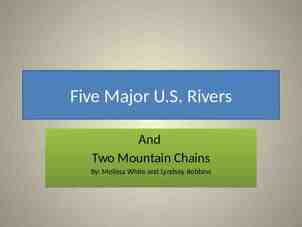SCENARIOS FOR CRITICAL RAW MATERIALS, THE CASE OF COBALT ESTER VAN
28 Slides1.41 MB

SCENARIOS FOR CRITICAL RAW MATERIALS, THE CASE OF COBALT ESTER VAN DER VOET LEIDEN UNIVERSITY, INSTITUTE OF ENVIRONMENTAL SCIENCES

Scenarios Various definitions of scenarios (dictionaries) a predicted sequence of events an imagined sequence of events an outline or model of an expected or supposed sequence of events Scenarios are plausible, challenging, and relevant stories about how the future might unfold, which can be told in both words and numbers. Scenarios are not forecasts, projections, predictions, or recommendations. They are about envisioning future pathways and accounting for critical uncertainties. (source: UNEP) van der Voet, 2019

Scenarios Scenarios are not precisely defined different scale levels different actors different purposes different types of (or no) quantification different starting points Scenarios are NEVER predictions They are (plausible)(relevant)(extreme)(possible) stories that help us think about the future van der Voet, 2019

Scenarios for raw materials Why scenarios for raw materials? To explore solutions to the resource challenge: The world becomes more populous and richer: demand for resources grows Supply struggles to keep up, bottlenecks may arise supply problems waste environmental impacts These bottlenecks form the boundary conditions for our use of resources van der Voet, 2019

Scenarios for raw materials Resource scenarios do not yet exist At global level, these are being developed by OECD (first effort published at WCEF Oct 2018) by UN-International Resource Panel How will / can / might future resource demand develop? What will be consequences if we do nothing / if we take action for supply waste environmental impacts? Critical materials not (yet) part of these global level efforts van der Voet, 2019

Scenarios for raw materials Scenarios for (critical) raw materials: storyline development quantification / modelling There is an exercise on storyline development Modelling: for all raw materials but ESPECIALLY critical raw materials it is important to distinguish between modelling DEMAND and modelling SUPPLY van der Voet, 2019

Scenarios for raw materials Modelling demand: Two possible approaches: “top-down” and “bottom-up” Top down demand modelling: using time series information of resource demand, and of relevant driving forces comprehensive enables linking with economic (CGE) models flow-based, Input Output tables as main resource module used by OECD in their energy scenarios and also in their resource scenarios (tbp) suitable for BAU, difficult for non-trend scenarios often lacking in detail, not suitable for CRMs van der Voet, 2019

Scenarios for raw materials Top down scenarios of metal resp. raw material demand, 2010-2050 resp. 2015 - 2060 6,00E 12 5,00E 12 4,00E 12 Policy First 3,00E 12 2,00E 12 Markets First Security First Sustainability First 1,00E 12 0,00E 00 source: Elshkaki et al., 2018 source: OECD, 2018 van der Voet, 2019

Scenarios for raw materials Modelling demand Bottom up: building it up from most detailed level of resource applications and using driving force variables to forecast these applications captures essential stock dynamics enables including CRMs and other minor materials used by PBL in their IMAGE-TIMER models to forecast energy systems suitable for non-trend scenarios stock-based, dynamic Material Flow Analysis, Life Cycle Assessment data intensive, database quite incomplete van der Voet, 2019

Scenarios for raw materials bottom-up scenario of steel stock development for buildings in China, 2010-2050 Steel stock in residential buildings in China, 1970-2050 8.00E 06 7.00E 06 million kg steel 6.00E 06 5.00E 06 high-rise urban steel appartments urban steel semi-detached urban steel 4.00E 06 detached urban steel 3.00E 06 high-rise rural steel appartments rural steel 2.00E 06 1.00E 06 semi-detached rural steel detached rural steel 0.00E 00 source: Marinova et al., forthcoming van der Voet, 2019

Scenarios for raw materials Modelling supply: specify how demand is supposed to be met different mines / countries different shares of secondary production (circular economy) different production routes, different efficiency of production processes Separate supply modelling essential when supply and demand are not automatically connected when an assessment of waste generation and environmental impacts is required: this depends on technologies. van der Voet, 2019

Scenarios for critical raw materials Critical materials are a special case Questions to be answered seem to be mostly industry related, and mostly short-term BAU: will specific industries be able to meet their raw materials requirements in the next few years how can we develop a business case for the production of certain CRMs more general questions, industry and government, are out there as well: will there be sufficient raw materials to upscale specific technologies how can we increase supply / develop substitutes / develop alternative technologies / create markets / temporise demand / go circular / . van der Voet, 2019

Scenarios for critical raw materials: demand Modelling demand of critical materials: top-down modelling usually impossible no data production often disconnected from demand no correlating driving force so bottom up modelling is the only option modelling of demand for applications assuming the CRM will be used according to plan van der Voet, 2019

Scenarios for critical raw materials : demand Bottom-up modelling of CRM demand demand for applications of CRMs combined with information on CRM content in applications large data gaps and high uncertainties data stops at raw material level: mining, production, and to some extent imports and exports of the raw material following materials up the supply chain not possible – or not public Input Output models covering supply chains not suitable translation from/into monetary terms doesn’t make sense insufficient level of detail in sectors material content data absent, or partial, or rapidly changing over time van der Voet, 2019

Scenarios for critical raw materials: demand Industry Co demand scenarios: short term trends (source: Roskill, 2018) van der Voet, 2019

Scenarios for critical raw materials: demand bottom-up scenario of Co demand world, SSP2 scenario, until 2050 with assumptions on Co content and on climate policy Co demand in 2050: 90 – 700 kt/y Source: Deetman et al., 2018 SSP 2 Baseline SSP 2 450 ppm Climate Policy et a m it s e t n et n o c o C w o L et a im ts e t n et n o c o C m u i d e M et a im ts e t n et n o c o C h gi H [Name], 2018

Scenarios for critical raw materials: demand What is the composition of products? Some data on “where does the material end up in” But very little data on product composition ProSUM project first attempt to systematically collect such data ( http://www.urbanmineplatform.eu/homepage) for batteries, vehicles and consumer electronics including changes in composition over time unfortunately, database not published van der Voet, 2019

Scenarios for critical raw materials: supply Modelling supply of CRMs? Dependent on many things besides demand prices demand for host material share of secondary production . Models of little use supply chain resilience models? Some estimates for the short term based on present situation In scenario exercises, focus is usually on demand van der Voet, 2019

Scenarios for critical raw materials: supply supply scenario for Co (Roskill, 2018) van der Voet, 2019

Scenarios for critical raw materials: supply supply scenario for Co (Tisserant & Pauliuk, 2016) van der Voet, 2019

References OECD, 2018: Global Material Resources Outlook to 2060 – Economic Drivers and Environmental Consequences (highlights brochure) Elshkaki et al., 2018: Environ Sci Technol. 2018 52 (5), 2491-2497 Roskill, 2018: Presentation Battery Supply Chain Europe 2018 Deetman et al, 2018: Environ Sci Technol. 2018 52(8):4950-4959 Tisserant & Pauliuk, 2016: Economic Structures (2016) 5: 4. https://doi.org/10.1186/s40008-016-0035-x van der Voet, 2019

Scenarios for critical raw materials: classroom exercise Exercise Scenarios for cobalt: Develop with your group a storyline for future cobalt demand and supply Make an assessment of cobalt demand and supply under this scenario Identify problematic issues and speculate on whether these could be solved Don’t worry about being accurate or realistic, this is NOT the purpose of this exercise See hand-outs! van der Voet, 2019

Scenarios for critical raw materials: classroom exercise There are four different types of scenarios (each group selects one via the envelope): rapid energy transition scenario circular economy scenario strict sourcing policies scenario black swan (some disaster happens) Scale is global, time horizon is up to 2050 A business-as-usual is provided, see handout, to use as a reference. van der Voet, 2019

Scenarios for critical raw materials: classroom exercise Step 1. specify the “background” system for your scenario socio-economic developments (population, welfare) technology developments (geo)political developments other relevant developments Pay special attention to deviations from trends. van der Voet, 2019

Scenarios for critical raw materials: classroom exercise Step 2. Specify demand (bottom-up) how will demand for Co containing applications develop in your scenario just relative trends is good enough: more / less than BAU drops or surges are especially interesting van der Voet, 2019

Scenarios for critical raw materials: classroom exercise Step 3. Speculate on consequences. You can use all information you have obtained in this course, or any other, or none, to support you are supply bottlenecks to be expected, and could something be done about that what are consequences for society at large van der Voet, 2019

Scenarios for critical raw materials: classroom exercise Step 4. Visualise: draft 1 figure to characterise your scenario Think of a name for your scenario Include demand and supply development for cobalt in this figure Step 5: present your scenario in 1 minute van der Voet, 2019

www.suscritmat.eu






